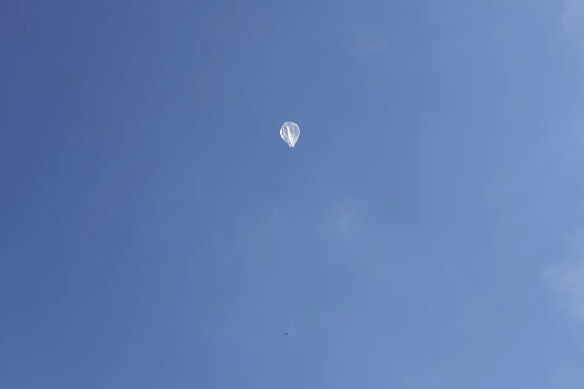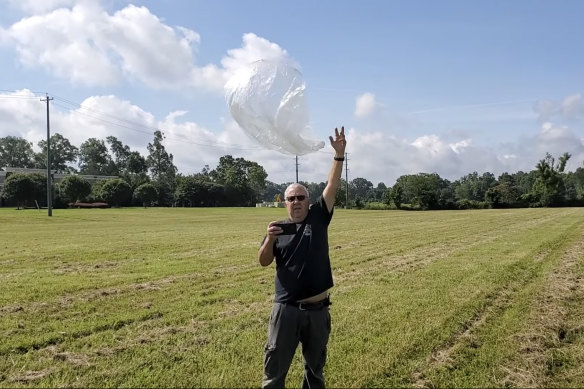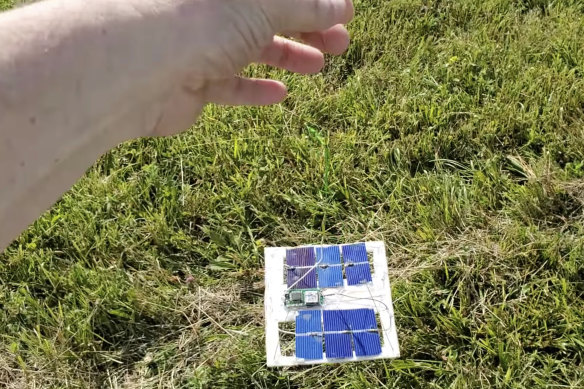Home » World News »
US used expensive missiles to take down what were likely $12 hobbyists’ balloons
Madison: Decisions to shoot down multiple unidentified objects over the US and Canada this month have put a spotlight on amateur balloonists who insist their creations pose no threat.
Over the last three weeks, US President Joe Biden has ordered fighter jets to shoot down three objects detected in US airspace — a suspected Chinese spy balloon off the South Carolina coast as well as smaller unidentified objects over Alaska and Lake Huron.
A pico balloon, which costs about $US12 and is about 80 centimetres in diameter. Medlin, owner of the Amateur Radio Roundtable podcast, believes a similar balloon is what the US military shot down over the Yukon recently. Credit:AP
Canadian Prime Minister Justin Trudeau last week ordered another object to be shot down over the Yukon; a US fighter jet carried out that mission.
US government officials have yet to definitively identify the objects, but Biden said on Thursday that they were probably balloons linked to private companies, weather researchers or hobbyists.
Tom Medlin, the owner of the Tennessee-based Amateur Radio Roundtable podcast and a balloon hobbyist himself, said he’s been in contact with an Illinois club that believes the object shot down over the Yukon was one of their balloons. No one from the club responded to messages left Friday, but Medlin said the club was tracking the balloon and it disappeared over the Yukon on the same day the unidentified object was shot down.
The clubs launch what are known as pico balloons, small mylar balloons equipped with trackers that can measure weather, temperature, humidity, or wind currents.
Ed Harrison launches a balloon in a field near Collierville, Tennessee. Credit:AP
The incidents have left balloonists scrambling to defend their hobby. They insist their balloons fly too high and are too small to pose a threat to aircraft and that government officials are overreacting.
“The spy balloon had to be shot down,” Medlin said. “That’s a national security threat, for sure. Then what happened is, I think, the government got a little anxious. Maybe the word is trigger-happy. I don’t know. When they shot them down, they didn’t know what they were. That’s a little concerning.”
White House National Security Council spokesman John Kirby said Friday that the Biden administration wasn’t able to confirm reports that the object belonged to the Illinois club. He said the debris has yet to be recovered and “we all have to accept the possibility that we may not be able to recover it.”
US officials said Friday that they’ve stopped searching for debris from the object shot down over Lake Huron and found nothing. Search efforts for debris from the Alaska and Yukon objects are ongoing.
Tom Medlin shows electronics attached to a pico balloon in a field near Collierville, Tennessee.Credit:AP
Kirby pushed back at the notion that Biden’s decision to use missiles costing hundreds of thousands of dollars to shoot down what were most likely balloons that cost less than $US20 was an overreaction.
“Absolutely not,” Kirby said. “Given the situation we were in, the information available, the recommendation of our military commanders — it was exactly the right thing to do at exactly the right time.”
Medlin said the balloons he’s flying right now cost about $US12 and are about 32 inches (81 centimetres) in diameter.
The balloons carry solar-powered transmitters that weigh less than 2 grams and that broadcast a signal every 10 minutes or so that ham radio operators around the world can use to track the balloons’ locations, he said. He has a balloon up right now that’s been in the air for 250 days and has circled the globe 10 times, he said.
The fun is watching the balloon circle the globe and building the tiny transmitters, said Medlin, adding that the devices are so small he needs a microscope to construct them. The National Oceanic and Atmospheric Administration has been collecting data from ham radio operators to track wind patterns, he said.
The balloons are so light that the Federal Aviation Administration doesn’t regulate them and doesn’t require balloonists to file flight plans, Medlin said. He inflates his balloons with enough hydrogen to ensure they’ll fly at about 50,000 feet. That is well above most commercial aircraft, he said.
Current regulations posted on the FAA’s website state that no one can operate an unmanned balloon in a way that creates a hazard, and agency regulations apply only to balloons that carry a payload of more than two kilos.
Medlin speculated that after US officials detected the suspected Chinese balloon, they adjusted their radar to pick up very small objects. But the hobbyists’ balloons don’t pose a threat to aircraft, he said.
“We’re following FAA rules and regulations,” Medlin said. “They’re the experts on whether this should or should not be done. Take a cork and drop it in the middle of the Pacific Ocean. Is a ship going to hit it? Probably not. And if it did it wouldn’t do any damage to the ship.”
Ron Meadows co-founded San Jose-based Scientific Balloon Solutions with his son, Lee. He said the company produces balloons as large as 8 1/2 feet in diameter for university and middle school science students.
He said those balloons carry a payload weight of around 10 to 20 grams, with transmitters the size of an icy pole stick. Some balloons feature a 6-metre antenna, he said.
He understands that government officials are trying to keep people safe, he said, but they don’t understand that the balloons are totally benign and there’s no question they’re overreacting. Jet engines likely ingest far larger objects, such as birds, and most pilots probably wouldn’t even know it if they hit a balloon, Meadows said.
He said he has tried to contact the US Department of Homeland Security and the Department of Defence to educate officials about the balloons, but that his calls went to voicemail.
“It would have been nice to get our government the information they needed,” he said.
Meadows said he anticipates that after this month’s incidents, the FAA will come out with tighter restrictions on balloons. He said he’s not overly concerned, since his balloon business is a side job; he also runs a swimming pool repair service.
“We are in this (balloon) business more for the students, not for making money,” he said. “This is for education. When we build these things, the time it takes to build them, we can make more at our day job.”
Medlin said balloons can reach speeds of up to 210 km/h if they get caught up in the jet stream. But Bob Boutin, a Chicago flight instructor, said its unlikely that such balloons pose much of a threat to aircraft.
Most commercial jets fly between 25,000 and 45,000 feet, below the balloons’ level, he said. Some corporate jets climb higher than 50,000 feet, but at that altitude skies are typically clear with visibility of 30-64 km, Boutin said.
The White House’s Kirby said that the objects shot down were travelling low enough to pose a risk to civilian aircraft, but Boutin said even at lower altitudes, a small balloon wouldn’t merit a military strike.
“Birds and planes are a heck of a lot more issue than a balloon would be,” he said. Even if the balloon were to enter a jet engine, “most jets have two engines, and if you lost one, technically it’s an emergency but not one that means the plane is going crash,” Boutin said.
AP
Get a note directly from our foreign correspondents on what’s making headlines around the world. Sign up for the weekly What in the World newsletter here.
Most Viewed in World
From our partners
Source: Read Full Article





